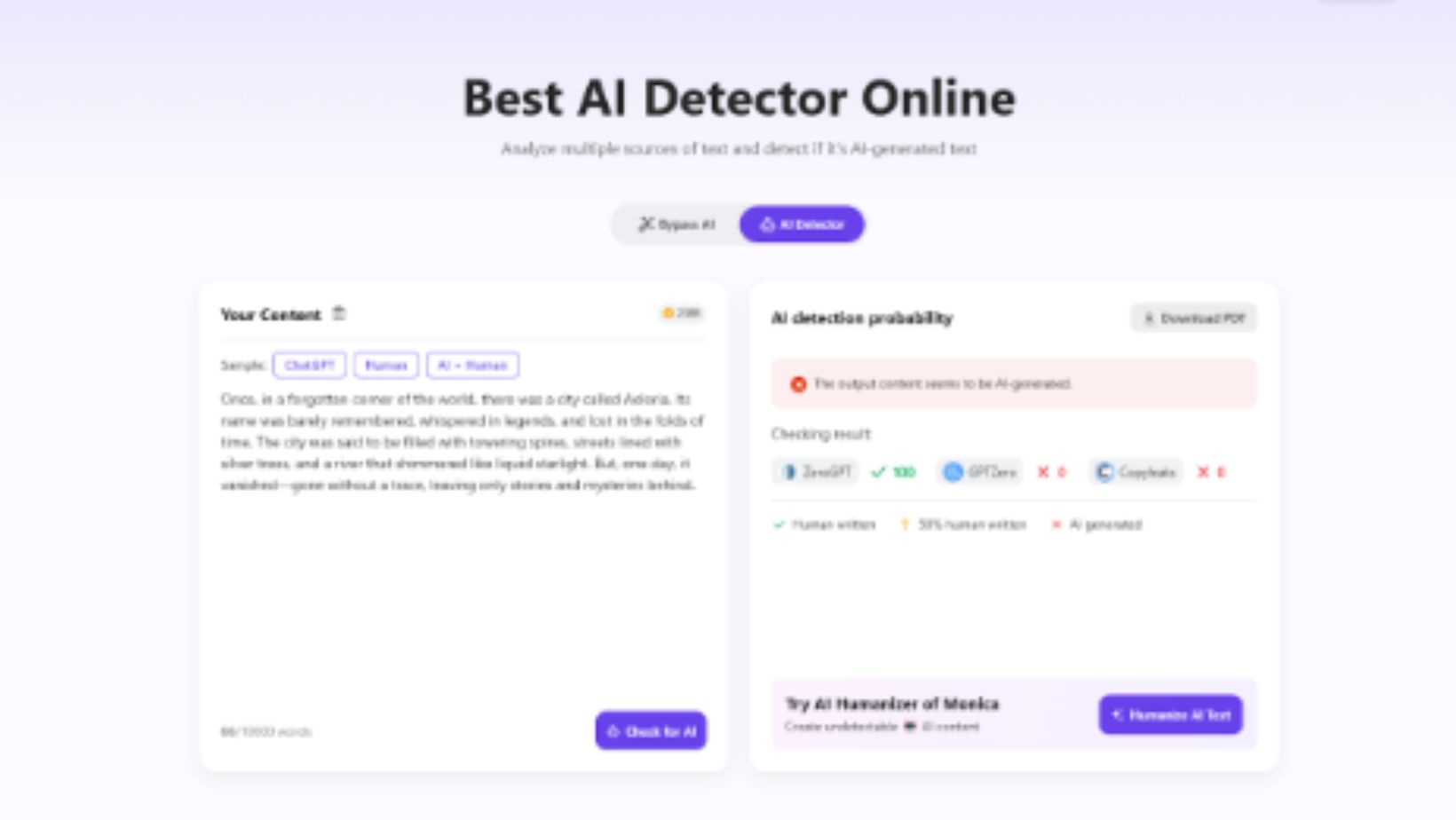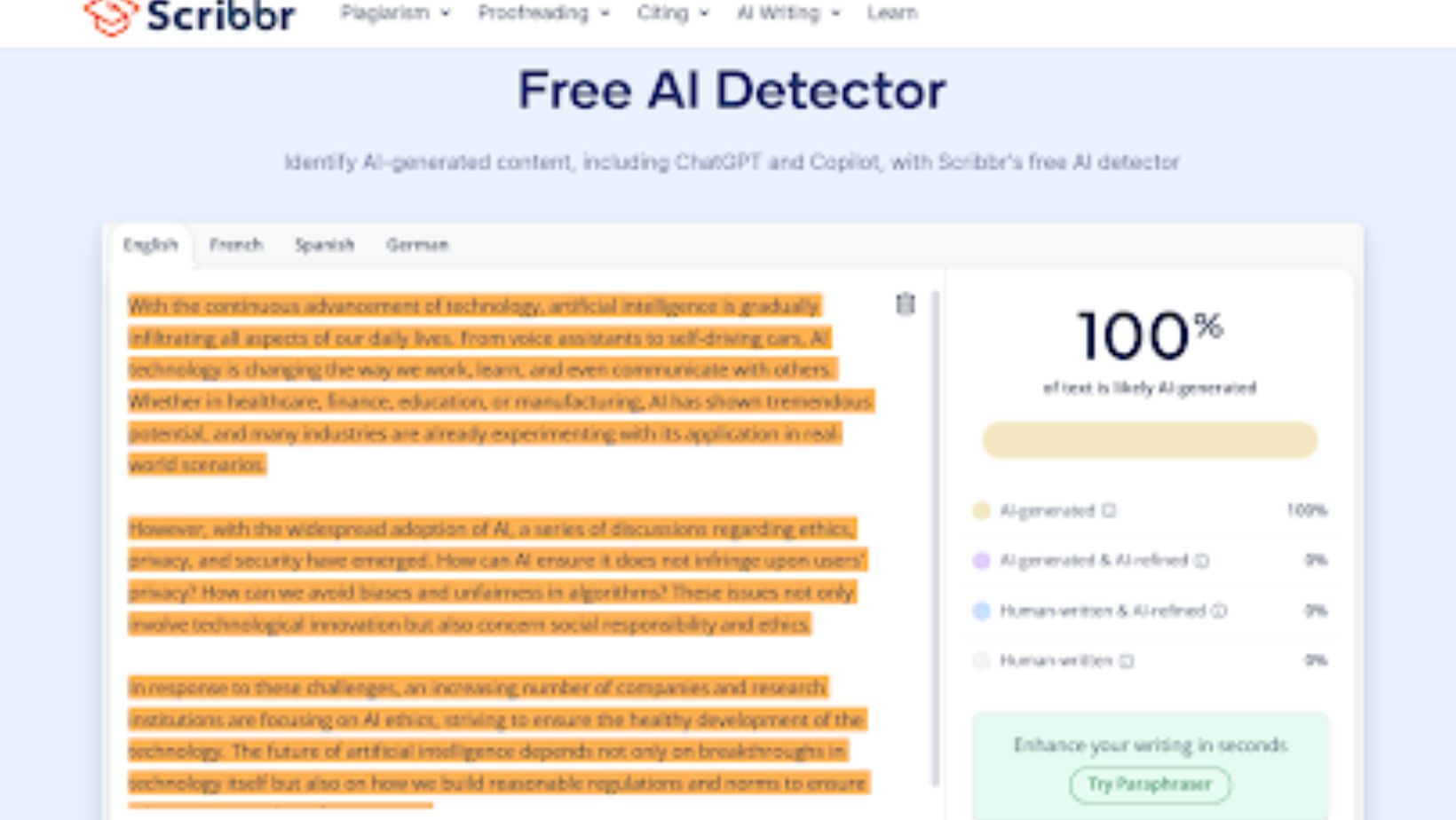
The rise of generative AI tools like ChatGPT, Bard, and Gemini has revolutionized content creation, offering unprecedented speed and efficiency. However, this technological leap has also spawned a new challenge: discerning human-written content from AI-generated text. As a tech media writer, I’ve witnessed this evolution firsthand, observing both the excitement and apprehension surrounding AI’s impact on writing. This has led to a surge in demand for reliable AI detection tools, a market now brimming with options. But how do you choose the right one? This deep dive explores the current landscape of AI content detectors, examining their features, limitations, and potential impact on the future of writing.
The Need for AI Detection: A Double-Edged Sword
The proliferation of AI-generated content has created a complex situation. While these tools can be incredibly useful for brainstorming, generating outlines, or even drafting initial versions, their misuse poses significant risks. From academic integrity concerns in education to the potential for spreading misinformation online, the need to identify AI-generated content is paramount.
Dissecting the AI Detection Toolkit: Features and Functionality
The table below offers a valuable overview of several prominent AI detection tools. Let’s break down some key observations:
| Tool | Detection Capabilities | Accuracy | Language Support | Implementation | Pricing | Pros | Cons |
| Monica’s AI Detector | Detects content generated by GPT-4o, Claude 3.5, Gemini 1.5 | High (99%+) | Multilingual (20+) | Simple interface, API integration, Chrome extension | Subscription-based, Free tier available | Robust features, multilingual support, easy-to-use | Premium plan required for full functionality |
| ZeroGPT | GPT-4o, Claude 3.5, Gemini 1.5 detection | High (95%+) | English (Limited) | Paste text interface, no file upload support | Free with limitations | Comprehensive, user-friendly interface, fast results | Limited language support |
| Scribbr’s AI Detector | Identifies GPT-4o, Claude 3.5, Gemini 1.5 text | Medium-High (85-90%) | English-only | Paste text, detailed report | Paid, with a free trial | Easy to use, fast detection | Limited to English content |
| GPTZero | GPT-4o, Claude 3.5, Gemini 1.5 | High (95-98%) | English, limited | Detailed analysis, provides writing style insights | Free with paid plans | Detailed analysis, good for style insights | False positives, requires high-quality input |
| ContentDetector.ai | Targets GPT-4o, Claude 3.5, Gemini 1.5 | Medium (85%) | English (Limited) | Text input, provides scores on AI likelihood | Subscription-based | Accurate for short texts, simple interface | Less reliable for long or edited texts |
- Monica.im: A Comprehensive AI Detection Tool
Monica is more than just a text detection tool; it integrates various functions to help content creators and educators streamline their workflow. The tool’s strength lies in its multilingual support, making it invaluable in a globalized world where content often crosses language barriers. With Monica, users can detect AI-generated content in various languages, a feature many competitors lack.

In addition to AI detector, Monica offers plagiarism checking, citation generation, and summarization tools. This combination makes it an all-in-one platform, which is especially beneficial for professionals who need to ensure content authenticity while also meeting academic or publication standards.
Key Features of Monica
- Multilingual Support
- Benefit: Monica can detect AI-generated content in multiple languages, which is a rare feature among other tools. This is especially useful if you work with international content or collaborate with colleagues around the world. It helps break down language barriers and ensures that all content, regardless of language, remains authentic.
- All-in-One Platform
- Benefit: Monica offers AI detection, plagiarism checking, citation generation, and summarization—all in one place. This makes it a convenient choice for professionals who need a reliable, comprehensive tool to manage content verification, especially when working on academic papers or publications.
- Comprehensive Content Verification
- Benefit: Monica goes beyond AI detection to ensure the originality and authenticity of your content. It’s an excellent tool for people who need to meet strict academic or publishing standards, providing features like plagiarism checking and citation generation alongside AI content detection.
- ZeroGPT: High-Accuracy Detection
ZeroGPT’s claim to fame is its 99% detection accuracy—a standout feature among many detection tools. The platform uses sophisticated algorithms to analyze writing style and detect traces of GPT-generated content. This high level of precision makes ZeroGPT especially useful for professionals who rely on accuracy in their work, such as journalists, content creators, and educators.

The tool’s simple and intuitive interface makes it easy for even non-technical users to perform checks quickly, making it ideal for anyone needing to verify content in a rush. One of ZeroGPT’s most useful features is its ability to analyze writing style—looking beyond simple AI fingerprints to assess whether the structure, tone, and word choice align with AI-generated patterns.
However, despite its high accuracy, ZeroGPT is primarily English-only, which limits its utility for global content creators or businesses. Its free version also imposes word-count restrictions, which may not be sufficient for longer documents or bulk checking.
Key Features of ZeroGPT
- 99% Detection Accuracy
- Benefit: ZeroGPT boasts an impressive 99% detection accuracy, making it one of the most reliable AI detection tools available. This high level of precision ensures that professionals like journalists, content creators, and educators can trust the tool to provide accurate results, reducing the risk of missing AI-generated content.
- Writing Style Analysis
- Benefit: Unlike other tools that only look for basic AI fingerprints, ZeroGPT goes deeper by analyzing writing style. It assesses sentence structure, tone, and word choice to detect subtle signs of AI influence. This feature helps you pinpoint AI-generated text, even if it’s blended with human writing, providing a more thorough evaluation.
- Simple, Intuitive Interface
- Benefit: ZeroGPT is easy to use, even for non-technical users. Its simple interface allows anyone to quickly upload their content and receive results, making it ideal for professionals who need to verify content in a hurry. This ease of use saves time and effort, especially when dealing with high volumes of text.
- Scribbr: A Student-Friendly AI Detection Tool
Scribbr has earned its reputation as a reliable tool for students and educators. The platform is widely used in academic circles for detecting both plagiarism and AI-generated content. Its user-friendly interface is designed with simplicity in mind, making it ideal for students who need a quick and efficient way to check their papers before submission.

What sets Scribbr apart is its focus on the academic integrity of student work. It provides detailed reports that help students understand the degree of AI involvement in their work, offering insights into what may need to be rewritten or rephrased to ensure authenticity.
On the downside, Scribbr is limited to English and lacks some of the more advanced features found in other tools. For example, while it provides solid plagiarism detection, it doesn’t offer the same level of depth in AI analysis as tools like Monica or GPTZero. Additionally, Scribbr’s free version only allows a limited number of checks before requiring a premium subscription.
Key Features of Scribbr
- User-Friendly Interface
- Benefit: Scribbr’s simple design makes it easy for students and educators to use. Whether you’re a first-time or experienced user, you can quickly upload your document and get results. This ease of use ensures you won’t waste time figuring out complicated settings or tools, making it perfect for students who need fast, efficient checks before submitting assignments.
- Focus on Academic Integrity
- Benefit: Scribbr helps students maintain the authenticity of their work by providing detailed reports on AI involvement. The tool highlights areas where AI may have been used, giving students the chance to adjust their writing and ensure it meets academic standards. This focus on academic integrity helps students avoid unintentional plagiarism and strengthens their overall writing process.
- Plagiarism Detection
- Benefit: Scribbr offers reliable plagiarism detection, making it an essential tool for students who want to ensure their work is original. The tool compares submitted content against a wide range of online sources, helping identify unoriginal sections and preventing unintentional plagiarism. This feature is crucial for maintaining trustworthiness in academic work.
- GPTZero: Detailed Analysis for Content Creators
GPTZero distinguishes itself by providing an in-depth analysis of writing style. This makes it particularly useful for content creators who want to understand the subtle differences between human and AI writing. GPTZero examines things like sentence structure, word choice, and even the rhythm of the text, helping users pinpoint exactly where AI-generated content might have been introduced.
One of the standout features of GPTZero is its detailed reports that offer specific insights into the nature of the AI influence. For example, it doesn’t just flag content as “AI-generated” but breaks down what part of the text follows an AI pattern. This makes it particularly useful for journalists or bloggers who may want to identify subtle traces of AI involvement without sacrificing creative originality.
However, while GPTZero offers a free version, it does come with some limitations. For example, long-form content can trigger false positives, where human-written text is mistakenly flagged as AI-generated. These issues may be especially problematic for creators working on large projects that require a high degree of trust in the tool’s accuracy.
Key Features of GPTZero
- In-Depth Analysis of Writing Style
- Benefit: GPTZero goes beyond simple AI detection by analyzing sentence structure, word choice, and text rhythm. This detailed approach helps users identify subtle differences between human and AI-generated writing. Content creators, such as bloggers or journalists, can use this feature to detect AI involvement without compromising the natural flow of their work. This deeper analysis ensures that users can maintain originality in their writing while verifying its authenticity.
- Detailed Reports on AI Influence
- Benefit: Unlike other tools that simply flag content as “AI-generated,” GPTZero provides detailed reports that specify which parts of the text show signs of AI influence. This breakdown is helpful for users who need to see exactly where AI might have been introduced in their writing. It helps journalists, bloggers, and other creators understand the nuances of AI involvement and adjust their work accordingly to maintain its integrity.
- Ability to Handle Mixed Content
- Benefit: GPTZero can differentiate between human and AI writing even in mixed-content scenarios where both human and AI contributions exist. This makes it an ideal tool for content creators who might incorporate both human writing and AI-generated elements. By identifying specific parts that follow AI patterns, users can ensure their content remains authentic and original, which is crucial for professionals working in fields where credibility is key.
- CopyLeaks: Comprehensive Detection for Professionals
CopyLeaks is known for its robust AI detection capabilities, which combine plagiarism detection with AI content analysis. This makes it a go-to solution for businesses, legal teams, and content creators who need to ensure that their text is not only original but also free from AI manipulation.
One of CopyLeaks’ standout features is its multilingual support, which allows users to detect AI-generated content in various languages. This makes it a valuable tool for global companies that produce content in different regions. The platform also offers integration with content management systems (CMS) and learning management systems (LMS), which streamlines the process for businesses and educational institutions alike.
However, the tool is not without drawbacks. Its premium pricing can be a deterrent for individual users or small businesses, and its complex interface may take some time to master for first-time users. Despite these challenges, CopyLeaks remains a comprehensive solution for professionals who require both advanced plagiarism detection and AI content verification.
Key Features of CopyLeaks
- Multilingual Support
- Benefit: CopyLeaks stands out with its ability to detect AI-generated content in multiple languages, making it invaluable for global businesses and content creators working across different regions. This feature ensures that companies with a multilingual audience can maintain content authenticity no matter where it’s published, without the need for separate tools for different languages.
- Plagiarism Detection & AI Content Analysis
- Benefit: CopyLeaks combines both plagiarism detection and AI content analysis in one tool, making it a comprehensive solution for businesses, legal teams, and content creators. This dual functionality ensures that the content is not only free from plagiarism but also untainted by AI manipulation, which is crucial for maintaining trust and originality in professional content.
- Integration with CMS and LMS
- Benefit: The platform’s integration with Content Management Systems (CMS) and Learning Management Systems (LMS) streamlines content verification and analysis for businesses and educational institutions. This makes it easier to implement content checks directly within the systems organizations already use, saving time and improving efficiency across workflows.
- ContentDetector.ai: Budget-Friendly Option
For small businesses or independent content creators looking for an affordable AI detection solution, ContentDetector.ai offers a solid, budget-friendly alternative. The tool is easy to use and provides basic detection capabilities, making it an excellent choice for those who need a simple, quick way to detect AI involvement in their content.
One of the key advantages of ContentDetector.ai is its affordability, with a free version available that allows for basic checks. While it doesn’t have the advanced features or detailed analysis of some of the other tools, it still offers sufficient accuracy for users who only need basic verification.
However, its limited feature set means that ContentDetector.ai may not be suitable for larger organizations or those in need of more advanced analysis. It is English-only and lacks the multilingual capabilities of tools like Monica or CopyLeaks.
Key Features of ContentDetector.ai
- Affordable Pricing
- Benefit: ContentDetector.ai offers a free version and affordable pricing for its premium version, making it a great option for small businesses or independent content creators on a budget. The free version allows for basic AI detection checks, making it accessible to anyone looking for a quick and cost-effective way to verify content authenticity without breaking the bank.
- User-Friendly Interface
- Benefit: The platform is simple and easy to use, making it ideal for users who need to perform AI checks without any complex setup or technical knowledge. This user-friendly design allows content creators and small businesses to quickly detect AI involvement in their content, saving time and effort, especially for those who don’t need advanced features.
- Basic Detection Capabilities
- Benefit: While ContentDetector.ai may not offer advanced features like other AI detection tools, it still provides sufficient accuracy for users who only need basic verification. This makes it an excellent choice for users who don’t require in-depth analysis and just want to ensure their content is free from AI influence without needing to invest in expensive tools.
Beyond the Basics: Evaluating Real-World Performance
While feature lists are helpful, the true test of an AI detector lies in its real-world performance. Factors like false positives (flagging human-written text as AI-generated) and false negatives (failing to detect AI-generated content) can significantly impact the tool’s usability.
From my experience, even the most advanced detectors are not foolproof. They often struggle with nuanced writing styles and can be easily fooled by minor edits to AI-generated text. This highlights the importance of using these tools as part of a broader evaluation process, combining them with human judgment and critical thinking.
The Future of AI Detection: An Ongoing Evolution
The AI detection landscape is constantly evolving, with new tools and techniques emerging regularly. As generative AI models become more sophisticated, so too must the detectors designed to identify them. This creates a dynamic interplay, a constant back-and-forth between AI creation and detection.
One promising area of development is the use of “watermarking” techniques in AI-generated content. This involves embedding subtle markers within the text that are invisible to the human eye but detectable by specialized software. This could offer a more reliable way to identify AI-generated content, even after it has been edited or modified.
Here’s a Little Secret You Should Know
Not all AI detection tools are created equal. Many on the market generate inaccurate reports due to subpar algorithms, which means you can’t always trust the results you get. However, Monica takes a different approach by constantly updating its API integrations with top-tier detection services, ensuring you get genuinely reliable and precise results. If you want a tool that stands out in terms of accuracy and real-time verification, Monica is your go-to choice.



